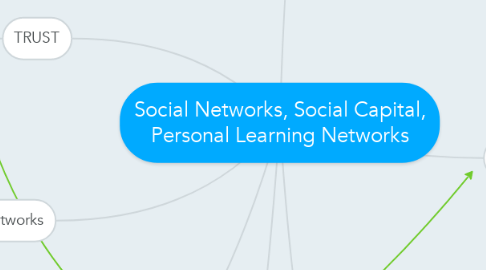
1. Network Capital (Blackwell)
1.1. What?
1.2. "Social capital that is embedded in interpersonal relations that can provide custom-tailored helpful resources that are flexible, efficient and effective."
1.2.1. .
1.2.1.1. "comes uncertainly from many loose ties"
1.2.1.2. Based on reciprocity (Does the Golden Rule, Rule?)
2. Social Networks
2.1. Why so important?
2.1.1. Allow individuals to:
2.1.2. Present themselves
2.1.3. Establish networks
2.1.4. Maintain connections
2.2. Types of Social Networking Sites
2.2.1. Work Related
2.2.1.1. "LinkedIn"
2.2.2. Romantic
2.2.2.1. "Friendster"
2.2.3. Topic Specific
2.2.3.1. "Music/Politics", 8tracks
2.2.4. Population Specific
2.2.4.1. "Facebook (college/hs)"
3. What's Wrong With Social Networks?
3.1. Navarro critique of Putnam:
3.2. Absence of power and politics
3.3. Call for more capitalists vs. call for togetherness
4. TRUST
4.1. "The sharing of social capital is based off of trusting relationships"
4.2. "Social Networks allow trust to spread transitively"
5. Personal Learning Networks (PLNs)
5.1. Cultivation Process (Rheingold)
5.1.1. Explore
5.1.2. Search
5.1.3. Follow
5.1.4. Tune
5.1.5. Feed
5.1.6. Engage
5.1.7. Require
5.1.8. Respond
5.2. How to Create? (Terrell)
5.2.1. Mimicking
5.2.2. Curating a good network of people (Passionate Learning Networks)
5.2.3. Willingness to listen, ask for help
5.2.4. 'Passing It On' (Become the teacher yourself)
6. Social Capital
6.1. What?
6.2. Pierre Bourdieu: "resources available to people as a result of durable relationships"
6.3. 3 Types (Terrell/Rheingold)
6.3.1. Bonding
6.3.1.1. Strong ties
6.3.1.1.1. Family
6.3.1.1.2. Neighbors
6.3.1.1.3. Co-workers
6.3.2. Bridging
6.3.2.1. Weaker/Distant Ties
6.3.3. Maintained/Linking
6.3.3.1. Dissimilar Circumstances/Comunities
6.4. "Boosted" by Social Network Sites (Particularly Bridging)
6.4.1. Facebook (Ellison)
6.4.2. Twitter
6.4.3. Tumblr
7. RECIPROCITY
7.1. Why so important?
7.1.1. Increases social capital
7.1.2. Low cost, flexible, efficient, effective source of social capital
7.1.3. Moral
7.1.4. Binds participants in mutual dependence
7.1.5. Increases societal cohesion
7.2. Types
7.2.1. Exchange resources
7.2.1.1. Restricted (similar)
7.2.1.2. Generalized (mixed)
7.2.2. Exchange Partners
7.2.2.1. Between 2 people (One to One)
7.2.2.2. Between Many (Network)
